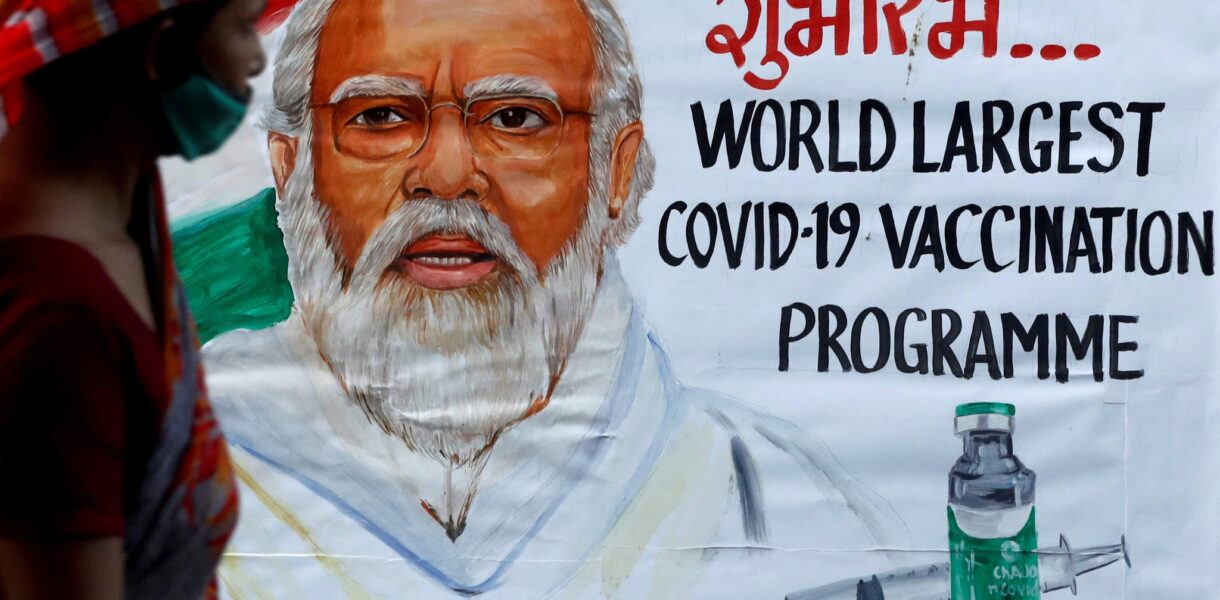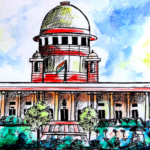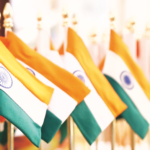

The month of December 2019[1] brought to the world the first signs of a virus that would bring the entire world to a stall by a pandemic of a magnitude unthinkable in modern times – the COVID – 19 pandemic or the Coronavirus pandemic. A pandemic[2] is basically a global epidemic – an epidemic that spreads to more than one continent. The first strains of the virus were found in Wuhan, China[3] and from there spread rapidly to the entire world, infecting and killing millions worldwide. Countries like the United States of America, India, Brazil, France, Italy etc. suffered the most.
When the pandemic first struck, countries sought to find medicines like Remdesivir, Favipiravir, Lopinavir etc. that could help in treating the symptoms of the disease but eventually it was realised that developing a vaccine was the most fitting solution to the pandemic. The scientific community all over the world came together for the cause of developing a foolproof vaccine for Covid -19 and the speed at which this happened was praiseworthy. Many tested and successful vaccines were developed around the world which included the ones developed by Oxford-AstraZeneca in the United Kingdom, registered by the name of Covishield in India, the shots developed by Pfizer/BioNTech, Moderna and Johnson & Johnson in the USA and the Sputnik-V vaccine from Russia. India also developed its indigenous vaccine called Covaxin produced by Bharat Biotech.
But where the complication arose was that the rich and developed countries instead of providing humanitarian aid to the countries that didn’t have ample amounts of vaccine doses, resorted to stockpiling of vaccines and pre-purchase agreements of huge amounts, i.e., resorting to vaccine nationalism.
1. What Is Vaccine Nationalism?
1.1 Vaccine Nationalism
“Vaccine nationalism”[4] is a phenomenon in which nations prioritize their domestic needs at the expense of others. When developed countries place massive pre-orders for vaccines, it increases competition and encourages companies to produce the best product, but it is not sustainable for the collective global effort in the long run. Developed nations usually claim the lion’s share of prospective doses for their own citizens in such a scenario. This acts as a major threat to the global efforts to equalize vaccine distribution, as these countries stockpile with a complete disregard for the prospects of the other countries, thus, massively decelerating the collective global efforts to combat the pandemic and making it long-drawn, resulting in more and more losses.
Let’s for example take a hypothetical situation –
A pandemic breaks out globally and a vaccine manufacturer in a country ‘X’ starts developing a vaccine. Due to the capital impetus provided by ‘X’ and also its pre-orders, the manufacturer is now bound to supply a majority of its vaccines to ‘X’. In a parallel case, ‘X’ also registers pre-purchase orders with a manufacturer in another country, thus effectively restricting a majority of its doses for sale. These two scenarios either individually or in conjunction are examples of how a country could showcase vaccine nationalism.
1.2 Historical Stance
A situation of such nationalistic behaviour and its problematic influence on the vaccine situation can be traced back to the 2009 H1N1 flu pandemic which killed approximately 284 thousand[5] people around the world.
A vaccine for H1N1 flu was developed in close to seven months from the initial development phase for a global rollout but many high-income countries directly made pre-purchase orders of huge numbers with the vaccine manufacturers and sought to purchase virtually everything that these manufacturers could produce, US alone obtained the right to buy almost 600,000 doses. [6]All these actions led to inequity in how the developing countries could gain access to the vaccines as they were shoved out due to these hoarding tendencies of the developed countries.
Eventually, WHO had to step in to secure a just share of vaccines for the developing countries by engaging in dialogues with vaccine manufacturers and imploring the developed countries for monetary help towards these nations. Many developed nations did agree to monetary and vaccine donations but only after ensuring that they had covered their own population.[7]
In the African nations in the 2000s, monopolistic actions of pharmaceutical companies led to the pricing of successful treatments for HIV/AIDS at up to $10,000 a year, [8]an amount which was well out of reach of individuals in these nations.
Hence, the distribution of H1N1 vaccines was based on the will and purchasing power of the high-income countries and other entities, not the risk of transmission or how the low-income nations would fare out in their individual vaccination drives against the pandemic.
2. Vaccine Nationalism In The Current Scenario
2.1 What Is The Present Scenario?
As discussed above, the Covid-19 virus that originated from Wuhan developed rapidly into a pandemic causing huge repercussions on a global scale. The virus infected millions around the globe causing huge overstraining of the medical systems eventually killing about 3 million people. Also, the extensive lockdowns in almost all of the countries to control the spiralling infection rates led to economic losses of huge magnitudes which were reflected in globally uniform data of falling national GDPs.[9]
The fight against the Covid-19 pandemic, which began from finding a cure to relieve the respective symptoms, transitioned to developing efficient vaccines and carrying extensive vaccination drives worldwide to curb the spread of the virus. Vaccines were developed rapidly by pharma companies and the Covid-19 vaccination programme with approximately 5 billion vaccinations[10] across the world was envisioned.
But vaccine nationalism came as a major hurdle in its successful implementation, high-income countries started stockpiling vaccines by placing pre-purchase orders of magnitudes that were even sufficient to vaccinate their own populations multiple times,[11] even going to the extent of blocking the export of both vaccines and other essential materials for vaccine production.
The US has entered into at least six bilateral deals, totalling more than 1 billion doses – way more than enough to inoculate the entire American population.[12] The number of vaccine doses that the EU ordered is sufficient enough for 900 complete vaccinations, amounting to a surplus of almost 525 million vaccinations. The UK ordered 219 million full vaccinations for its adult population of roughly 54 million, a surplus of 165 million. Canada ordered 188 million full vaccinations for its 32 million adults a surplus of 156 million.[13] But the glaring fact is that these countries account for a meagre 14% of the world population.[14]
2.2 Why Should We Be Concerned?
2.2.A. Moral Implications
This policy of “vaccine nationalism” is not only morally wrong[15] but also is an unsustainable methodology to go about reducing global transmission. UNICEF Executive Director Henrietta Fore and WHO Director-General Dr Tedros Adhanom Ghebreyesus while making a joint press release, stated that Covid-19 has proved that our fates are linked together and, in this vaccine race we all either win together or lose together. [16]
Dr. Ghebreyesus in the annual executive board meeting of WHO stated that the world is on the edge of a ‘catastrophic failure’ and this ‘me first’ approach would lead to keeping the world’s poorest and most vulnerable at risk.[17]
Thus, the sad reality of today is that while the developed and deep-pocketed countries are implementing vaccination programmes at huge magnitudes and at an express pace, the developing countries are yet to even begin their vaccine programs due to the lack of vaccines.
2.2.B. Absence Of International Legal Frameworks
Currently, there exist no international treaties and frameworks which dictate the preparation for dealing with a pandemic or a legally applicable document that specifies how a vaccine is to be distributed in an equitable manner. This absence of an enforceable framework gives countries free rein when they try to hoard vaccines or marketize vaccines for their personal profit as they fear no repercussions.
2.2.c. Slow Development of Herd Immunity
Herd immunity or population immunity is a phenomenon when an entire population is immune to a specific disease, this immunity can be developed either through vaccination or immunity built up due to a previous infection. Researchers estimate that to achieve herd immunity against Covid-19 virus, approximately 70-85% of the population[18] has to be completely vaccinated.
According to calculations, it would take approximately 4.6 years[19] to inoculate the population up to this level, thus, slowing down the development of herd immunity. Hence, this policy of vaccine nationalism can prove to be clinically counterproductive, as slowing down the rate of herd immunity would eventually lead to higher caseloads and deaths. Also in the time required to vaccinate the unvaccinated population, more mutants of the Coronavirus could develop which could lead to the current vaccines being rendered ineffective against them, further complicating the global fight against the pandemic.[20]
2.2.D. Crumbling Healthcare Systems
The current Covid scenario has greatly magnified the crumbling healthcare facilities in some lower-end countries. A parameter that can be used as an indication for this is the doctors per capita ratio in such nations; WHO prescribes a 1:1000 doctor-patient ratio but nations like Afghanistan (0.3), Bangladesh (0.6), India (0.6), Cambodia (0.2), Congo (0.1), Egypt (0.5), Ethiopia (0.2) and many more perform dismally in this metric.[21] The low-income status also implies a lesser developed health infrastructure in such countries rendering them even more fragile by the onslaught of a prolonged pandemic leading to poor treatment and probably a higher death toll.
3. Stakeholders
In the introductory lines of the book, The Politics of Vaccination – A Global History, the authors state, “Government-organized vaccination campaigns are projects that presume to shape the immunity of whole populations”.[22] Thus, we can say the exercise of vaccination is in essence a political exercise.
Whenever a vaccination drive is initiated in a nation then apart from the goal of vaccination, there always exists a goal to strengthen the identity of the political leaders of the country ‘within’ the nation as well as to shape an identity ‘of’ the nation at the global level. The ‘within’ aspect takes place as we develop a positive image of the leader who heralds a successful vaccination drive within the country; while the ‘of’ aspect is achieved when at the global level the country’s exercise is perceived as the ‘model vaccination drive’ bolstering its diplomatic image.
Thus, whenever vaccination is perceived as an exercise to fuel the political identities and diplomatic image, the leaders subconsciously engage in vaccine nationalism.
3.1 Wronged
The policy of vaccine nationalism has given rise to a massive inequality between the developed and the developing countries in terms of vaccine availability and vaccination rates. According to reports provided by WHO[23] as of April 9, even though almost 770 million vaccine doses have been administered in the world, just a minuscule, 0.2% of this number have been administered in low-income countries. Dr. Ghebreyesus in WHO briefing said that on average, 1 in 4 persons have received the vaccine in high-income nations but in the low-income countries this data drops drastically to just 1 in 500.[24]
According to some estimates, due to this inequality, approximately 80-90% of the population residing in some 67 low-income countries would not have received any of the doses of vaccine by the end of the year which exposes them to the risks like higher caseloads and death counts as pointed out above. The African Union as a whole claimed some 270 million doses of the vaccine but they could never start the acquisition process due to a fund crunch.
Joe Biden in the US brought into effect the Defence Production Act (DPA) of 1950 that contains clauses that force U.S. based pharmaceutical and associated sector companies to produce vaccines and other essential items for domestic production only. [25]This move caused a global furore as it posed a hurdle to the distribution of vaccines and other essential items considering that US is a pharmaceutical giant.
3.2 Wrongdoers
Developed nations and pharmaceutical companies that engaged in vaccine nationalism directly or indirectly during the COVID-19 pandemic, perpetuated inequity in terms of vaccine availability to poorer countries and thus acted as hurdles in the global fight against the pandemic.
Some instances where countries were the wrongdoers –
- In April 2020, Donald Trump, the then US president, halted funding for the WHO, thus derailing its efforts against the pandemic.[26]
- According to the London-based analytics company Airfinity, countries like the US, Britain, European Union and Japan have, as of August 2020, secured about 1.3 billion doses of potential Covid-19 vaccines and pending doses amount to a whopping 1.5 billion in number. The firm has also predicted that the worldwide supply of vaccines may not even reach 1 billion doses until the first quarter of 2022.[27]
- In May 2021, the US administration decided to give advance payment to AstraZeneca to the tune of almost 1.2 billion dollars, in order to obtain 300 million doses of the vaccine to be delivered in October. This payment to the company was under Trump’s Operation Warp Seed that works for securing vaccines for US citizens as early as possible.[28]
- Developing nations like Kenya, Brazil etc. that had registered for doses under COVAX have been hanging on for want of doses as only a fraction of the promised doses has been received by these nations. This shortfall is due to the lack of the Astra-Zeneca vaccine which SII produces and India exports.
Similarly, some instances where pharma giants were the wrongdoers –
- The CEO of Serum Institute of India (notably the world’s largest producer of vaccine doses), Adar Poonawalla, reportedly said that a large share of its vaccines would go to the people of India itself before they are exported abroad.[29]
- The CEO of Sanofi (a France based pharmaceutical giant), Paul Hudson stated that the US had the right to the largest pre-order of vaccines because of an investment agreement signed between his company and the U.S. Biomedical Advanced Research and Development Authority (BARDA) in February 2021.[30]
- Likewise, AstraZeneca (a UK based company) said that the first thirty million doses of the vaccine it’s developing with help of the Oxford University would be allocated to the UK. This pharmaceutical company reported that this is due to an investment of seventy million dollars made by the country.[31]
4. Solutions To Vaccine Nationalism And A Prolonged Pandemic
4.1. COVAX
The COVAX initiative began in April 2020, led by WHO, Global Vaccine Alliance(GAVI), and the Coalition for Epidemic Preparedness Innovations (CEPI) with UNICEF working as an implementation partner. It is also one of three pillars of the Access to COVID-19 Tools (ACT) Accelerator. By 15 July 2020, 165 countries covering 60% of the world population had become a part of COVAX.[32]
One of the major aims of COVAX is to create a level of equitable access of vaccines to everyone around the globe irrespective of the income levels and for that purpose, it aims to make 2 billion doses available by the end of the year and also for 20% of countries’ population[33] thus it acts as a mitigating platform against vaccine nationalism.
But it is crucial to mention that COVAX is falling short of its goal. As of 11 April 2021, only 38.5 million doses were delivered against a goal of 100 million by the end of March.
Thus, we need to devise some other probable solutions to combat this menace of vaccine nationalism.
4.2. The Road Ahead
4.2.a. Stop Marketization Of Vaccines
A plausible action that can be undertaken to rein in vaccine nationalism is to stop treating vaccines as a commodity to be marketed, rather they should be considered as public goods. This would ensure that vaccines are distributed around the world on a humanitarian basis rather than being used as a profit raking mechanism.
Currently, vaccine companies follow voluntary licensing i.e., these companies control whom to give the vaccine production rights to, thus, they cement their monopoly in the market to control prices. In the current circumstances, how these companies garner and use their profit should be monitored and they should be instructed to work in a way that could increase production capacity even if it makes them lose their patent rights over the vaccines.[34]
4.2.b. Remove The Political Element From Vaccination
Vaccination as an exercise should be stripped of all political influence so that leaders can’t use vaccines to burnish their own political images.[35] Thus, rather than politicians, experts like virologists, epidemiologists, medical scientists and social science experts should be leading the vaccination initiative by making policy decisions with scientific strategies at the forefront.
Committees of such experts must be made at the national level in all the countries with vaccine developing capacity, these can act as a single node body to communicate to the government about the steps to be followed. This would eliminate the nationalistic tendencies that creep in with politics while also ensuring that vaccine distribution is being done scientifically and equitably. These committees could also take lessons from previous initiatives of large-scale vaccination drives like those against Polio, H1N1, smallpox etc.
Further, a committee of similar experts can be made at the international level which could work along with WHO to coordinate the functioning of these national committees.
4.2.c. Framing Of International Treaties On The Matter
The absence of an international legal framework or treaty is a cause of worry[36] in the global initiative against the pandemic. Thus, international frameworks are an immediate need of the hour. WHO in some of its recent briefs has promoted the idea of an international framework for pandemic preparedness as floated by a slew of global leaders.[37]
The WHO constitution has provisions (Article 2(g))[38] that allow it “ to stimulate and advance work to eradicate epidemic, endemic and other disease.”. Article 2(g) is also strengthened by the International Health Regulations of 2005[39] which give WHO the power to control the international spread of diseases.
Some suggestions that could be included as a part of this treaty –
- Provisions to ensure compulsory financial commitments from the developed nations towards developing nations. This could facilitate the latter to mount an equally strong defence against the pandemic so that they could bolster their healthcare systems and improve vaccine purchasing capacity. This measure would be in consonance with Article 25 of the UDHR[40] which provides a standard level of health and well-being with appropriate healthcare in case of sickness or disease.
- Agreements signed between WHO and pharmaceutical companies could enforce upon them, a compulsory pledging of a share of the produced vaccines to nations that have failed to procure the requisite number of vaccines doses due to vaccine nationalism. This share should be decided by effective computing of the global supply and demands and should also be variable to accommodate changing circumstances. This would work to fulfil Goal 4 of the SDG Goals for 2030[41] by giving these countries a shot at good health and well-being.
- Supervisory committees chaired by the WHO consisting of experts from medicine and virology need to be constituted. These committees should have the responsibility of providing scientific data that drives the vaccine distribution systems with the added responsibility of working with nation-level committees[42] on the matter.
- Provisions for constitution of assessment committees to look into the shortcomings that the global health infrastructure has experienced during this pandemic. Equipped with these reports, a robust preparedness strategy should be developed, mechanisms for sharing appropriate scientific and medicinal know-how about the virus and essential treatments as well as for research and innovation purposes.
4.2.D. Waiver Of Patents And IPR
In the race for Covid-19 vaccines, pharma companies getting Trade-Related Aspects of Intellectual Property rights over these vaccines and extending their monopoly, effectively places profits before lives. Thus, a way to resolve this problem is by pressing for waiver of patents and TRIPS rights that these companies hold for vaccines. This would lead to the development and formulation techniques being available at an equitable level to all vaccine manufacturers so that vaccine production could accelerate.
WHO and other premier medical authorities need to draft policies or regulatory measures that either warn or impose punitive actions against countries that engage in actions that protect these IPR rights over an equitable distribution. These actions could involve a process of positive responsibility, binding the offending nations to shoulder responsibility for the vaccination efforts in the affected countries or funding their vaccination exercises. This could be done just like the Carbon market approach as proposed by the Paris agreement of COP 21.
In the current paradigm, India and South Africa with 90 other countries[43] have led an initiative at the WTO, to consider a TRIPS waiver for Covid – 19 vaccines which would ease licensing and lower the manufacturing costs. But pharma giants like the US, EU, UK and China[44] have unanimously opposed so as to favour their own national pharma interests. The above measures can be used to control such behaviour of these countries.
3.2.E. Misinformation Control And Myth-Busting To Improve Vaccination Control
Apex medical bodies like WHO, GAVI and People’s Vaccine Alliance need to run large scale education campaigns about vaccination and its role in ending the pandemic; to debunk myths that exist about the vaccines which deter the populations from getting vaccinated. A concentration of such measures needs to be at the rural level where the information reaches late. These efforts at correcting misinformation and falsifying myths would lead to a greater reach of the vaccines at all levels.
Taking an example of an incident,[45] that took place in Sisuada village in the state of UP, where villagers jumped into rivers or fled their homes to avoid getting vaccinated as they believed that they would be hospitalised with severe illness post-vaccination; as a result, only 14 out of the 1500 residents of the village could be vaccinated. If such education measures would have been undertaken at the grassroots, then any such incident could have been avoided.
5. Conclusion
It is high time that developed and high-income countries realise that until and unless they stop engaging in vaccine nationalism and abandon the ‘me before us’ attitude, the pandemic will not subside in the near future. Countries must realise that it is the Covid-19 virus that is their common enemy and they must unite together to stave off the threat of a prolonged pandemic.
We must keep in mind that if we wish to return to a pre-pandemic world then a majority of the world population needs to get vaccinated to achieve levels of herd immunity and thus vaccines would be able to solve the Covid crisis only if every nation is guaranteed timely and equitable access to it. Thus, countries must note that just vaccinating their own populations to protect their self-interests is not enough to fight this pandemic but they should provide for their neighbours and the world at large, to steer an effective global fightback.
As we have established throughout the course of this essay the threat that vaccine nationalism brings in its wake and the challenges it would create for the global community, thus to shun this nationalistic stance towards vaccines is our best bet to bring about an equitable platform, where vaccines will be distributed on the metric of whosoever faces the highest threat, not whosoever possesses the deepest pockets.
About The Authors
References
-
David J. Cennimo, Scott J. Bergman, Keith M. Olsen, How did the coronavirus outbreak start ?, Medscape (June 3, 2021) https://www.medscape.com/answers/2500114-197402/how-did-the-coronavirus-outbreak-start. ↑
-
Available at https://www.webmd.com/cold-and-flu/features/what-is-pandemic ↑
-
Available at https://www.who.int/news/item/27-04-2020-who-timeline—covid-19 ↑
-
Yasmeen Sehran, Vaccine Nationalism is Doomed to Fail, The Atlantic, (Dec. 8, 2020), https://www.theatlantic.com/international/archive/2020/12/vaccine-nationalism-doomed-fail/617323/. ↑
-
Dr. Fatimah S Dawood et al., Estimated global mortality associated with the first 12 months of 2009 pandemic influenza A H1N1 virus circulation: a modelling study, 12 THE LANCET 687, 687 (2012), https://www.thelancet.com/journals/laninf/article/PIIS1473-3099(12)70121-4/fulltext#secd2345083e1375. ↑
-
Abhishek De, Explained: Vaccine nationalism, and how it impacts the Covid-19 fight, INDIAN EXPRESS (Aug. 23, 2020), https://indianexpress.com/article/explained/what-is-vaccine-nationalism-how-does-it-impact-the-fight-against-covid-19-6561236/. ↑
-
David P. Fidler, Negotiating Equitable Access to Influenza Vaccines: Global Health Diplomacy and the Controversies Surrounding Avian Influenza H5N1 and Pandemic Influenza H1N1, 7 Plos Med 1, 1 (2010), https://journals.plos.org/plosmedicine/article?id=10.1371/journal.pmed.1000247. ↑
-
Available at https://www.unaids.org/en/resources/presscentre/featurestories/2021/march/20210310_covid19-vaccines ↑
-
M. Szimigiera, Impact of the coronavirus pandemic on the global economy – Statistics & Facts, STATISTA (June 11, 2021), https://www.statista.com/topics/6139/covid-19-impact-on-the-global-economy/. ↑
-
Niladri Chatterjee, Zaad Mahmood and Eleanor Marcussen, Politics of Vaccine Nationalism in India: Global and Domestic Implications, 48(2) F. for Dev. Stud. 357, 358 (2021), https://www.tandfonline.com/doi/pdf/10.1080/08039410.2021.1918238?needAccess=true. ↑
-
Rebecca Weintraub, Asaf Bitton, Mark L. Rosenberg, The Danger of Vaccine Nationalism, HARVARD BUSINESS REVIEW (May 22, 2020), https://hbr.org/2020/05/the-danger-of-vaccine-nationalism. ↑
-
Id. ↑
-
Robin Cohen, COVID vaccines: rich countries have bought more than they need – here’s how they could be redistributed, THE CONVERSATION (Feb. 9, 2021), https://theconversation.com/covid-vaccines-rich-countries-have-bought-more-than-they-need-heres-how-they-could-be-redistributed-153732. ↑
-
Chatterjee et al., supra note 10, at 359. ↑
-
Weintraub et al., supra note 11. ↑
-
Available at https://www.who.int/news/item/10-02-2021-in-the-covid-19-vaccine-race-we-either-win-together-or-lose-together ↑
-
Emma Farge, Vaccine nationalism puts world on brink of ‘catastrophic moral failure’: WHO chief, REUTERS (Jan. 18, 2021), https://www.reuters.com/article/us-health-coronavirus-who-idUSKBN29N0TB. ↑
-
Jennifer Huizen, Herd immunity may take 4.6 years due to vaccine nationalism, MEDICAL NEWS TODAY (April 9, 2021), https://www.medicalnewstoday.com/articles/herd-immunity-may-take-4-6-years-due-to-vaccine-nationalism. ↑
-
Id. ↑
-
James Darwin N. Lagman, Vaccine nationalism: a predicament in ending the COVID-19 pandemic, 43 Jour. of Pub. Health 375, 376 (2021), https://academic.oup.com/jpubhealth/article/43/2/e375/6175261. ↑
-
Available at https://data.worldbank.org/indicator/SH.MED.PHYS.ZS ↑
-
CHRISTINE HOLMBERG et al., THE POLITICS OF VACCINATION: A GLOBAL HISTORY 1 (Manchester University Press 2017). ↑
-
Available at https://news.un.org/en/story/2021/04/1089392 ↑
-
Id. ↑
-
Simran Sirur, US embargo on exporting Covid vaccine raw materials and how it could impact India, THE PRINT (Apr. 21, 2021), https://theprint.in/theprint-essential/us-embargo-on-exporting-covid-vaccine-raw-materials-and-how-it-could-impact-india/643374/. ↑
-
Andrew Joseph, Helen Branswell, Trump: U.S. will terminate relationship with the World Health Organization in wake of Covid-19 pandemic, STAT (May 29, 2020), https://www.statnews.com/2020/05/29/trump-us-terminate-who-relationship/. ↑
-
De, supra note 6. ↑
-
Available at https://www.defense.gov/Explore/Spotlight/Coronavirus/Operation-Warp-Speed/ ↑
-
Zeba Siddiqui, India’s Serum Institute to make millions of potential coronavirus vaccine doses, REUTERS (Apr. 28, 2020), https://www.reuters.com/article/us-health-coronavirus-india-vaccine/indias-serum-institute-to-make-millions-of-potential-coronavirus-vaccine-doses-idUSKCN22A2YY. ↑
-
Weintraub et al., supra note 11. ↑
-
Id. ↑
-
Available at https://en.wikipedia.org/wiki/COVAX ↑
-
Dr. Seth Berkeley, COVAX Explained, GAVI (Sept. 3, 2020), https://www.gavi.org/vaccineswork/covax-explained. ↑
-
See infra 4.2.d. ↑
-
See supra 3. ↑
-
See supra 2.2.b. ↑
-
Available at https://www.who.int/news/item/30-03-2021-global-leaders-unite-in-urgent-call-for-international-pandemic-treaty ↑
-
WORLD HEALTH ORGANISATION, BASIC DOCUMENTS 2 (World Health Organisation 2014). ↑
-
Available at https://www.who.int/health-topics/international-health-regulations#tab=tab_1 ↑
-
UNITED NATIONS GENERAL ASSEMBLY, UNIVERSAL DECLARATION OF HUMAN RIGHTS 5 (Department of State, United States of America 1949). ↑
-
Available at https://www.un.org/development/desa/disabilities/envision2030.html ↑
-
See supra 4.2.b. ↑
-
Huizen, supra note 18. ↑
-
Hyo Yoon Kang, Patent Capital in the Covid-19 Pandemic: Critical Intellectual Property Law, CRITICAL LEGAL THINKING (Feb. 9 2021), https://criticallegalthinking.com/2021/02/09/patent-capital-in-the-covid-19-pandemic-critical-intellectual-property-law/. ↑
-
Sanjay Pandey, Villagers jump into river to avoid Covid-19 vaccination in Uttar Pradesh, DECCAN HERALD (May 23, 2021), https://www.deccanherald.com/national/north-and-central/villagers-jump-into-river-to-avoid-covid-19-vaccination-in-uttar-pradesh-989075.html. ↑




